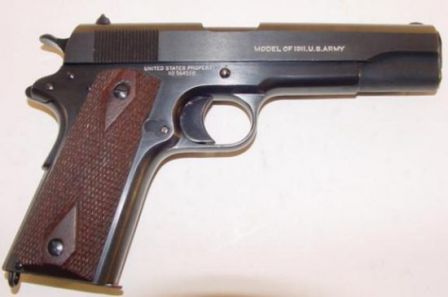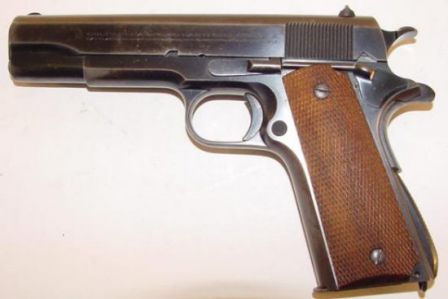Tuesday, May 29, 2012
Monday, May 28, 2012
"Ragged Old Flag" by Johnny Cash
A prideful salute to those who didn't make it home...
A sympathetic salute to those who did...
We come not to mourn our dead soldiers, but to praise them.
~ Francis A. Walker
A sympathetic salute to those who did...
We come not to mourn our dead soldiers, but to praise them.
~ Francis A. Walker
Friday, May 25, 2012
Madd Maxx FINALLY get's the bird!
HOOOOOOOOOAH!
 |
Thank you to all my MOFO squad team mates for helping me to reach bird status! Madd Maxx |
Madd Maxx.. on Parenting
Mr. Lahey:
Shit tectonics - do you know what happens when two shit plates collide? Shitquake...
Thursday, May 24, 2012
Tuesday, May 22, 2012
-mofo do you know your weapons?
Episode 2 from AZsithlord_mofo
By request for klesk_mofo
"Shotguns, what can I say, lets start with firepower on demand... versitile weapons that can be used for hunting, CQB(close quarters combat) riot control, breaching and a score of other uses that i just dont have the space for...
Personally have used everything from .410, 16 and 12 gauge pump and auto varities, bird shot to slugs, nothing clears the room or gets the bad guys attention and it just doesn't let you down."
Combat shotguns

The shotgun is probably the oldest type of all shoulder-fire firearms. Many earliest guns were smoothbore and loaded with multiple projectiles simultaneously. The shotguns were and still are used for hunting, since multiple projectiles increase the chances to hit the target with one shot, but shotguns also were used in combat in almost all wars since their introduction. The devastating short-range firepower and flexibility in loads are the key advantages of shotguns as the fighting weapons. During the XX century shotguns seen lot of combat, both as a police riot weapons and as a military trench, and later - jungle and urban close quarters battle weapons. Police used shotguns for riot and crowd control, and as a general purpose short and medium range weapons for about 150 years. First well known military use of shotguns is dated back to the Great War (1st World War), when Allied forces used various pump-action and self-loading shotguns in the trench warfare. During the 2nd World War shotguns were used as a security weapons (for guarding and anti-riot purposes), for close combat in jungle environments of SE Asia, where the self-loading shotguns (like the Remington 11 and Auto-5 - both of Browning design) proved to be very valuable for their devastating short-range firepower. The shotguns were also used for aerial gunnery training. Vietnam war also seen many shotguns used by US troops in the jungles, but these were mostly pump-action shotguns. At the present time shotguns formed a valuable part of equipment of both police and military forces around the world, and its development continued. There were several programs intended to increase shotguns effectiveness and combat range, but these proved mostly to be less than successful. Most combat shotguns were and still are the adaptations of commercial, hunting firearms for the new role, but during the last three decades of the XX century some specialized combat shotguns were developed. Some of these remained only in prototype or pre-production status, others flourished and found its way into the police and military stocks.

Combat shotguns usually designed with two basic action styles - repeating "pump-action" or semi-auto. Double-barreled shotguns were also used in early periods, but these are too slow to reload for combat purposes. However, a sawed-off versions of the double shotguns, with the most of the barrel and the butt removed, seen some use on both sides of law as a very-short range, hide-away weapons of devastating power.
General features of shotgun.
Main advantages of shotguns are their versatility and short-range firepower. Shotguns can fire multiple projectiles of various sizes, creating a lethal pattern, which will increase chances of hitting target, or single large projectile, powerful enough to drop down a large brown bear, or incapacitate a human being protected in all but the heaviest body armour. Shotguns also can fire special purpose ammunition, such as door buster slugs, and even a high explosive and incendiary rounds, as well as the less lethal ammunition, useful for riot control and other police operations. Most, if not all modern combat shotguns are magazine fed repeaters, with the underbarrel tubular magazines being the most common type. Those magazines offer a sleek, slim profile of the gun, but are slow to reload. Some recently developed combat shotguns featured a detachable, box-type magazines, which can be replaced very quickly. Few combat shotguns were developed with rotary, revolver-like magazines or drum-type magazines of relatively large capacity (10-12, and up to 28 rounds), but those magazines are extremely bulky, heavy, expensive and sometimes slow to reload.
The disadvantages of the combat shotguns are the limited effective range of fire (about 50-70 meters with standard buckshot, up to 100-150 meters with specially designed subcaliber or fleschette loadings). Shotguns also are sometimes relatively large (especially when compared to modern submachine guns), and can have a heavy recoil with the most powerful loadings. The size and weight of the shotgun ammunition effectively limits both the magazine capacity and the amount of ammunition a soldier can carry in the mission.
Pump action shotguns

Pump action means, that for each shot shooter cycles the handguard back and forward (in some guns, such as Russian RMB-93 or S. African Neostead - forward then back). This movement removes the used shell, cocks the action and chambers the new shell. This design is little slower than semi-auto, but offers greater flexibility in shotshells selection, allowing mixing of the different types of loads and usage of low-power or unreliable loads. This feature especially useful for police and home defense usage, since the pump-action shotguns can fire low-powered less-lethal ammunition (with tear gas or rubber buckshot).


Semi-automatic shotguns


Monday, May 21, 2012
BF3 Damage Analyzer
Check out this BF3 damage analyzer. This is a pic of the weapons compare tool. Be sure to check out the other tools available as well.
Who does this remind you of?
It is funny. Twice in the last couple months, friends have said I am like "The World's Most Interesting man" on those Dos Equis commercials because I have so many diverse interests. Well, Dave Hummel, aka AZSithLord posted this on my Facebook because it reminded him of someone....
Loken
Monday, May 14, 2012
_mofo do you know your weapons?
by
AZsithlord_mofo
information courtesy of world.guns.ru
"Probably my most relished memories of my military career was the honor to carry this fine piece of history. As a standard sidearm during my entire 6 years as Military Police, it was reliable and hard hitting (at least on the range, as i thankfully never had to use it in agression). I choose this weapon frist as I believe it is the only one to be in all but one of the Battlefield games(BF2042?)"
U.S. Pistol M1911A1
U.S. Pistol M1911 made by Colt
U.S. Pistol M1911A1 made by Colt
The history of the Colt Gov't / M1911 Pistol began in early 1900s, when famous designer John M. Browning began to develop semi-automatic pistols for Colt company. In the 1906-1907 U.S. Army announced trials to replace its service revolvers with new, semi-automatic pistol. Army required the new pistol to have the caliber of .45 inch, so Browning designed its own cartridge that fired 230 grains (14.9 gram) bullet, and then, designed a new pistol. In 1911, after extensive testings, the new pistol and its cartridge, designed by Browning and manufactured by Colt, were adopted for U.S. military service as M1911. Prior to and during World War One, more than one million of these guns were manufactured, mostly by Colt and Springfield Armoury, as well as by Remington-UMC, Burroughs, Savage and some other companies. The rights to manufacture Colt/Browning design were also sold to some foreign countries, such as Norway or Argentine.
The history of the Colt Gov't / M1911 Pistol began in early 1900s, when famous designer John M. Browning began to develop semi-automatic pistols for Colt company. In the 1906-1907 U.S. Army announced trials to replace its service revolvers with new, semi-automatic pistol. Army required the new pistol to have the caliber of .45 inch, so Browning designed its own cartridge that fired 230 grains (14.9 gram) bullet, and then, designed a new pistol. In 1911, after extensive testings, the new pistol and its cartridge, designed by Browning and manufactured by Colt, were adopted for U.S. military service as M1911. Prior to and during World War One, more than one million of these guns were manufactured, mostly by Colt and Springfield Armoury, as well as by Remington-UMC, Burroughs, Savage and some other companies. The rights to manufacture Colt/Browning design were also sold to some foreign countries, such as Norway or Argentine.
In 1926, original design was improved, following
the recommendations of the US Army Ordnanve Dept. These changes incorporate the
following items (see picture above):
1. Wider front sight
2. Longer hammer spur
3. Shorter trigger
4. Curved spring housing
5. Simplified grip panels checkering
6. Index finger reliefs behind the trigger
7. Longer grip-safety spur
1. Wider front sight
2. Longer hammer spur
3. Shorter trigger
4. Curved spring housing
5. Simplified grip panels checkering
6. Index finger reliefs behind the trigger
7. Longer grip-safety spur
The improved design was adopted by US Military as
M1911A1 pistol, and served with distinction until the mid-1980s, when it was
officially replaced in service with M9 pistol (US-made Beretta 92FS).
The commercial Colts of this design are known as
Government models. In 1929, Colt introduced the Government pistol in its new
chambering, the .38 Super Automatic, a hotter version of the earlier .38
Automatic cartridge. New pistol had bigger magazine capacity (9 rounds) and sold
well on the police market. The .38 Super versions are still manufactured and
used mostly as competition guns due to extreme accuracy.
During the 1970 - 1983, Colt manufactured Mk.IV
series 70 Government model pistols, which closely resembled original M1911A1s,
but with accurized barrel bushings. Since 1983, Colt manufactured Mk.IV Series
80 Government model pistols, that featured added firing pin safety. Latest Colt
product, M1991A1, also featured Series 80 slide with firing pin safety.
Colt also developed some more compact versions of
its full-size commercial guns. So called "Commander" versions (available as
Combat Commanders, Lightweight Commanders with alloy frames etc) have shortened
barrels and slides (barrel lenght 108 mm, or 4.25 inch), with the standart size
frame and grip, and standart magazine capacity of 7 rounds in .45ACP. These guns
were also available in .38 Super and 9mm Luger chamberings. In the year 1972, US
Army adopted the M15 General Officers Model Pistol, developed by Rock Island
Arsenal, wery similar to Combat Commander, as a selfdefence weapon for high
level army officers. These guns had a brass plate insert in the left grip panel,
where tha name of the owner should be engraved.
Even more compact version, the Colt Defender, had also the shorter grip that limits magazine capacity to 6 rounds of .45ACP. The barrel of Defender is of 76 mm lenght (3 inch). Commercial Colt Officers' pistols were also very similar to Defenders.
Along with Colt, countless numbers of companies in
the USA and other countries manufactured more or less exact copies of the M1911.
Some millions of guns were manufactured in the USA during the WW2 by numerous
companies under US Government contracts, and probably even more were
manufactured for commercial sales. Most common M1911 clones are manufactured by:
Springfield armoury, Les Baer, Kimber, Wilson, STI, Para Ordnance and many, many
others. Also, many M1911-partterned pistols are still custom built for service
duty, sport shooting and self defence.
Technically, the M1911 is a recoil operated,
locked breech semi-auto pistol. It has single action trigger with frame mounted
safety that locks the hammer and the slide. Hammer could be locked either in
cocked or in lowered position, allowing the gun to be carried in "cocked
and locked" state, with safety on, hammer cocked and round chambered. Additional
automated safety incorporated into rear of the grip and locks the action when
gun not held in the hand properly.
Barrel and slide are interlocked via massive lugs onthe upper part of the barrel, just ahead of the chamber. After the shot is fired, the barrel and the slide go back for the short distance, then rear part of the barrel is lovered by tilting link, and barrel unlocks the slide. The slide goes all the way back, extracting and ejecting spent case and chambering the new round on the way back. When magazine is empty, the magazine follower activates slide stop that locks the slide in the open (rear) position. The gun is fed from the single stack, seven round magazine. The magazine release button is located on the left side of the frame, just behind the triggerguard.
Barrel and slide are interlocked via massive lugs onthe upper part of the barrel, just ahead of the chamber. After the shot is fired, the barrel and the slide go back for the short distance, then rear part of the barrel is lovered by tilting link, and barrel unlocks the slide. The slide goes all the way back, extracting and ejecting spent case and chambering the new round on the way back. When magazine is empty, the magazine follower activates slide stop that locks the slide in the open (rear) position. The gun is fed from the single stack, seven round magazine. The magazine release button is located on the left side of the frame, just behind the triggerguard.
Sunday, May 13, 2012
Happy Mother's Day from the Mofo Squad
Here's a little something from the Mofo Squad to all you Moms out there on your extra special Mother's Day...
Have dinner ready. Plan ahead, even the night before, to have a delicious meal ready on time for his return. This is a way of letting him know that you have been thinking about him and are concerned about his needs. Most men are hungry when they get home and the prospect of a good meal is part of the warm welcome needed.
The Good Wife's Guide
From
Housekeeping Monthly, 13 May, 1955.
Have dinner ready. Plan ahead, even the night before, to have a delicious meal ready on time for his return. This is a way of letting him know that you have been thinking about him and are concerned about his needs. Most men are hungry when they get home and the prospect of a good meal is part of the warm welcome needed.
Prepare yourself. Take 15 minutes to rest so you'll be refreshed when he arrives. Touch up your make-up, put a ribbon in your hair and be fresh-looking. He has just been with a lot of work-weary people.
Be a little gay and a little more interesting for him. His boring day may need a lift and one of your duties is to provide it.
Clear away the clutter. Make one last trip through the main part of the house just before your husband arrives. Run a dust cloth over the tables.
During the cooler months of the year you should prepare and light a fire for him to unwind by. Your husband will feel he has reached a haven of rest and order, and it will give you a lift too. After all, catering to his comfort will provide you with immense personal satisfaction.
Minimize all noise. At the time of his arrival, eliminate all noise of the washer, dryer or vacuum. Encourage the children to be quiet.
Be happy to see him.
Greet him with a warm smile and show sincerity in your desire to please him.
Listen to him. You may have a dozen important things to tell him, but the moment of his arrival is not the time. Let him talk first - remember, his topics of conversation are more important than yours.
Don't greet him with complaints and problems.
Don't complain if he's late for dinner or even if he stays out all night. Count this as minor compared to what he might have gone through at work.
Make him comfortable. Have him lean back in a comfortable chair or lie him down in the bedroom. Have a cool or warm drink ready for him.
Arrange his pillow and offer to take off his shoes. Speak in a low, soothing and pleasant voice.
Don't ask him questions about his actions or question his judgment or integrity. Remember, he is the master of the house and as such will always exercise his will with fairness and truthfulness. You have no right to question him.
A good wife always knows her place!
Saturday, May 12, 2012
For Us that Drink too much Beer!!
This might just be Fun!!!
Link to full video
Monday, May 7, 2012
Close Quarters Donya Fortress Gameplay Trailer
Looks like another blood bath!
Subscribe to:
Posts (Atom)







